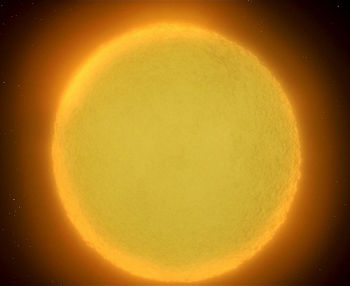Difference between revisions of "Alpha Centauri system"
m |
m |
||
| Line 93: | Line 93: | ||
[[Category:VOY]] | [[Category:VOY]] | ||
[[Category:ENT]] | [[Category:ENT]] | ||
| − | [[Category: | + | [[Category:Kelvin]] |
[[Category:STO]] | [[Category:STO]] | ||
[[Category:Film]] | [[Category:Film]] | ||
Revision as of 02:52, 25 July 2018

| Affiliation: | United Federation of Planets[1] |
| System Type: | Trinary[2] |
| Primary Star: | Name: Alpha Centauri A[2] Stellar Class: Type G2V [2][3] Planets: I: Doru (Class B)[3] II: Jannuik (Class B)[3] III: Kolmyri (Class M)[3] IV: Alpha Centauri IV (Alpha Centauri, Centaurus) (Class M)[3][4] V: Lessai (Class J)[3] VI: Vagoth (Class J)[3] VII: Seldarian (Class J)[3] VII: Killner (Class J)[3] IX: Estavor (Class J)[3] X: Katanahes (Class J)[3] XI: Asephas (Class C)[3] XII: Thulann (Class B)[3] XIII: Izach (Class D)[3] Other Stellar Objects: Nebula-like cloud of gas surrounds Seldarian (Alpha Centauri VII)[3] |
| Companion Stars: | Name: Alpha Centauri B[2] Spectral Class: Type K3V[2][3] Planets: The system's 13 planets orbit both Alpha Centauri A & B Name: Proxima Centauri (Alpha Centauri C)[2][3][5] Spectral Class: Type M3V[2][3] Planets: None |
A trinary star system, Alpha Centauri is located 4.35 light years from the Sol system[5] in the Alpha Centauri Sector (aka Sector 002) of the Beta Quadrant[2] Alpha Centauri A is a Type G2V (bright yellow dwarf) star, similar to Sol, and Alpha Centauri B is a Type K3V (orange dwarf) star. The third star, Proxima Centauri, is a Type M3V (bright red dwarf) star. The system's thirteen planets orbit both Alpha Centauri A and B; Alpha Centauri B is too small and dim to exert much influence over the planets in the system, while Proxima Centauri is even dimmer, so far away that it is scarcely visible in the daytime skies of Alpha Centauri IV.[5]
Planets
Inner Planets
Class B planets,[2][3][Notes 1] Doru (Alpha Centauri I) and Jannuik (Alpha Centauri II) are unremarkable. Neither possesses an atmosphere or satellites, although the Centaurans have space stations in orbit of both for scientific research. A malfunction of the propulsion system of the Doru station in 2365 required the assistance of the U.S.S. Odyssey NCC-71832 to prevent the station from crashing into the planet.[3]
Inhabited Planets
The third planet in the Alpha Centauri system, Kolmyri (Alpha Centauri III) was terraformed to be Class M[3] in the 23rd century.[5] The first successful use of the Centaurans' environmental technology, Kolmyri holds a large colony. The planet's orbit keeps it relatively close to Alpha Centauri IV,[3] and it has an average temperature of 26°C.[5]
Alpha Centauri IV, also known simply as Alpha Centauri[5] or, less commonly, as Centaurus,[4] is home to the Centaurans, a species nearly identical to Humans, save for a few minor differences in the placement of internal organs,[3][5] as well as a significant population of Human and Vulcan immigrants. The planet's most distinguishing celestial feature is its series of rings. The planet has two moons, Nykos and Tharon.[3]
Gas Giants
Alpha Centauri's fifth through tenth planets are all Class J gas giants of various sizes; several of their moons are home to starbases and small colonies. The planets are known as Lessai (Alpha Centauri V), Vagoth (Alpha Centauri VI), Seldarian (Alpha Centauri VII), Killner (Alpha Centauri VIII), Estavor (Alpha Centauri IX), and Katanahes (Alpha Centauri X) to the Centaurans. Seldarian suffered a major impact at some point in its history, ripping away several layers of its atmosphere. A cloud of colorful gases now surrounds the planet, and Starfleet Academy uses the cloud to train cadets for nebula operations.[3]
Outer Planets
The outer planets lay far from Alpha Centauri, at a distance equivalent to the Sol system's Kuiper Belt. The planets are known as Asephas (Alpha Centauri XI, Class C), Thulann (Alpha Centauri XII, Class B), and Izach (Alpha Centauri XIII, Class D).[Notes 1] Izach takes 500 years to complete one revolution around Alpha Centauri, and the discovery of raw dilithium on Thulann caused a number of free traders to scour the edges of the system in hopes of further, profitable discoveries.[3]
|
|